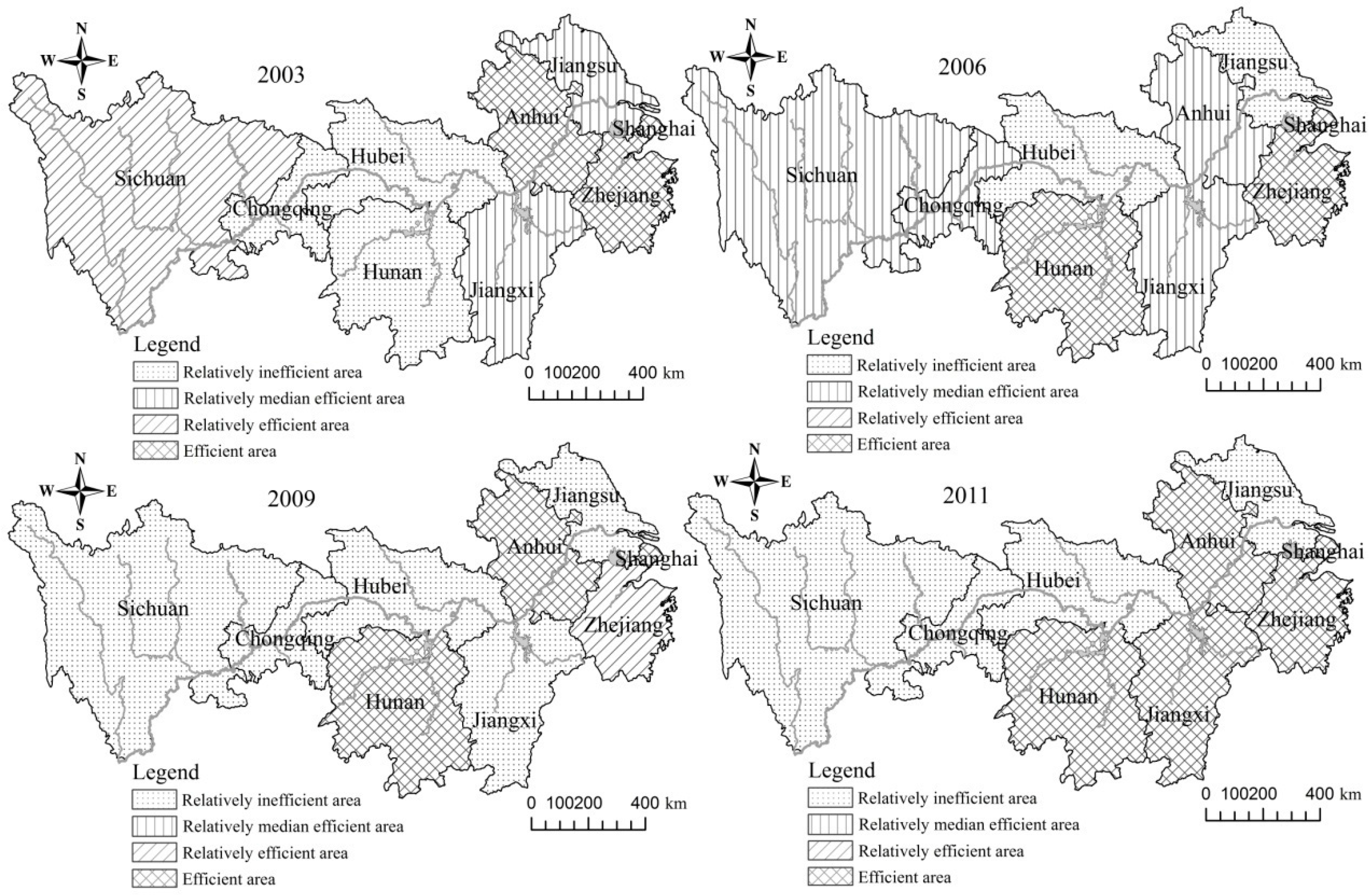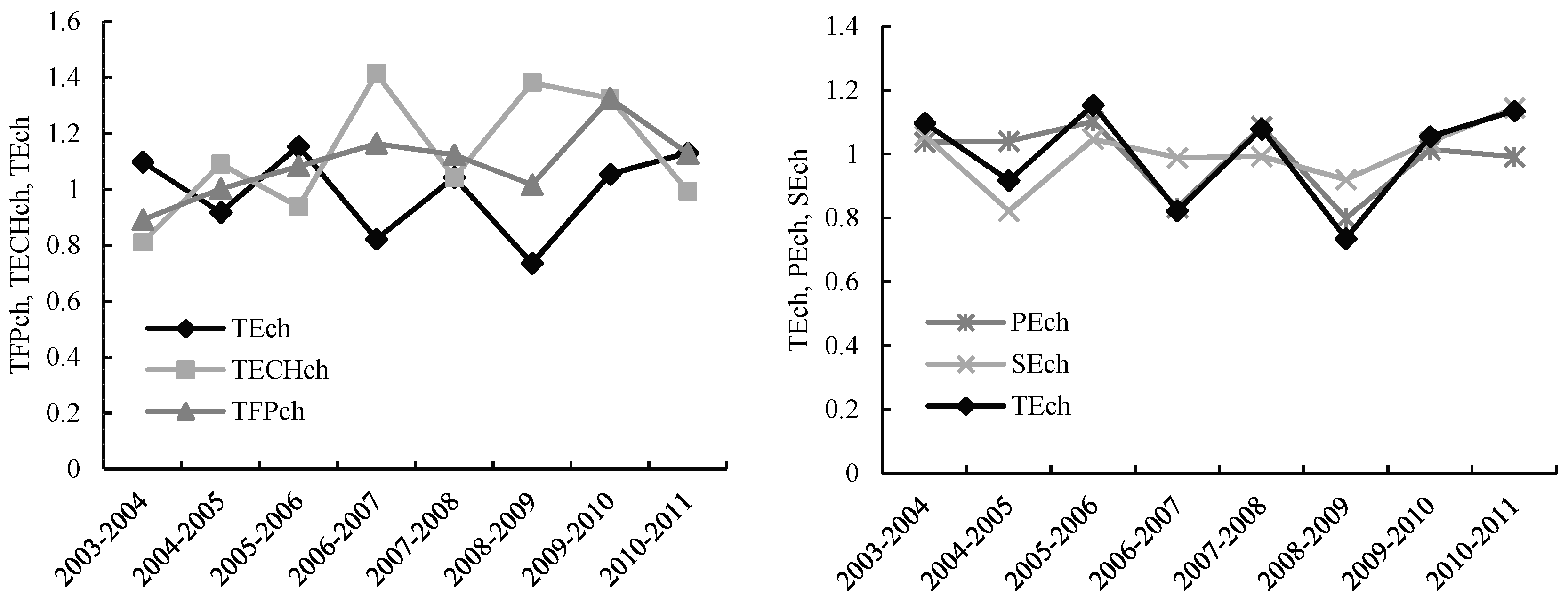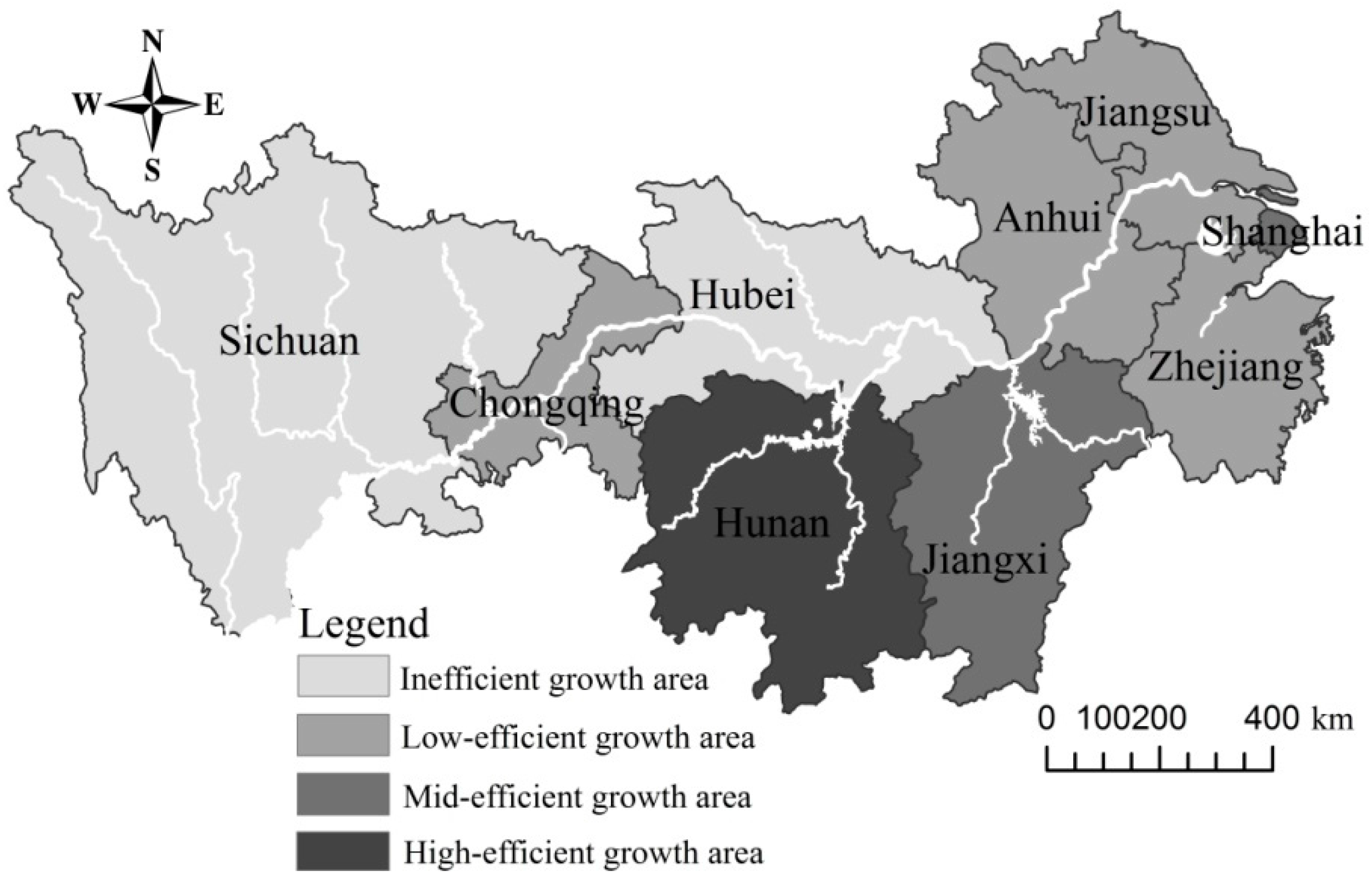Measuring Water Transport Efficiency in the Yangtze River Economic Zone, China
Abstract
:1. Introduction
Study Area
2. Materials and Methods
2.1. The DEA Model
2.2. The Malmquist Index
2.3. Index Selection and Data Processing
3. Results
3.1. Spatial Pattern Evolution of Water Transport Efficiency Based on the DEA Model
The Overall Spatial Pattern Evolution of Water Transport Efficiency
3.2. Regional Spatial Pattern Evolution of Water Transport Efficiency
3.3. Changing Trends and Spatial Characteristics of Water Transport Efficiency Based on the Malmquist Index
3.3.1. Overall Change Trend Characteristics of Water Transport Efficiency
3.3.2. Spatial Characteristics of Water Transport Efficiency Trends
4. Discussion
Acknowledgments
Author Contributions
Conflicts of Interest
References
- Wei, W.; Youhui, C.; Shuangbo, L. Review of transport efficiency and its research trends from the transport geography perspectives. Prog. Geogr. 2013, 32, 243–250. [Google Scholar]
- Woo, S.H.; Pettit, S.J.; Kwak, D.W.; Beresford, A.K.C. Seaport research: A structured literature review on methodological issues since the 1980s. Transp. Res. A Policy 2011, 45, 667–685. [Google Scholar] [CrossRef]
- Lau, Y.Y.; Ducruet, C.; Ng, A.K.Y.; Fu, X. Across the waves: A bibliometric analysis of container shipping research since the 1960s. Marit. Policy. Manag. 2017, 44, 667–684. [Google Scholar] [CrossRef]
- Cullinane, K.; Wang, T.F.; Song, D.W.; Ji, P. A comparative analysis of DEA and SFA approaches to estimating the technical efficiency of container ports. Transp. Res. A Policy 2005, 40, 354–374. [Google Scholar] [CrossRef]
- Itoh, H. Efficiency changes at major container ports in Japan: A window application of data envelopment analysis. Rev. Urban Reg. Dev. Stud. 2002, 14, 133–152. [Google Scholar] [CrossRef]
- Pevcin, P. Efficiency levels of sub-national governments: A comparison of SFA and DEA estimations. TQM J. 2014, 26, 275–283. [Google Scholar] [CrossRef]
- Ramanathan, R. A holistic approach to compare energy efficiencies of different transport modes. Energy Policy 2000, 28, 743–747. [Google Scholar] [CrossRef]
- Joanna, G.; Wysokińska, Z. Transport accessibility in light of the DEA method. Comp. Econ. Res. 2014, 17, 55–70. [Google Scholar]
- Boame, A.K. The technical efficiency of Canadian urban transit systems. Transp. Res. E Policy 2004, 40, 401–416. [Google Scholar] [CrossRef]
- Barnum, D.T.; Karlaftis, M.G.; Tandon, S. Improving the efficiency of metropolitan area transit by joint analysis of its multiple providers. Transp. Res. 2011, 47, 1160–1176. [Google Scholar] [CrossRef]
- Cantos, S.; Pastor, M.J.M.; Serrano, M.L. Productivity, efficiency and technical change in the European railways: A non-parametric approach. Transportation 1999, 26, 337–357. [Google Scholar] [CrossRef]
- Liangjie, Y.; Wei, W.; Su, Q.; Jiang, X.; Wei, Y. Evaluation of road transport efficiency in China during 1997–2010 based on SBM-undesirable model. Prog. Geogr. 2013, 32, 1602–1611. [Google Scholar]
- Wu, Y.C.J.; Goh, M. Container port efficiency in emerging and more advanced markets. Transp. Res. E Logist. Transp. Rev. 2010, 46, 1030–1042. [Google Scholar] [CrossRef]
- Calles, B. Fluvial Transportation in the River Västerdalälven. Geogr. Ann. Ser. A Phys. Geogr. 1980, 62, 63–74. [Google Scholar] [CrossRef]
- Gutiérrez, E.; Lozano, S.; Furió, S. Evaluating efficiency of international container shipping lines: A bootstrap DEA approach. Marit. Econ. Logist. 2014, 16, 55–71. [Google Scholar] [CrossRef]
- Blume, A.L. A Proposal for funding port dredging to improve the efficiency of the nation’s marine transportation system. J. Marit. Law Commer. 2002, 33, 37–89. [Google Scholar]
- Yip, T.L.; Lun, Y.H.V.; Lau, Y.Y. Scale diseconomies and efficiencies of liner shipping. Marit. Policy Manag. 2012, 39, 673–683. [Google Scholar] [CrossRef]
- Bowersox, D.J.; Closs, D.J.; Cooper, M.B.; Bowersox, J.C. Supply Chain Logistics Management, 4th ed.; McGraw-Hill: Singapore, 2013. [Google Scholar]
- Taofang, Y.; Feng, Z.; Hong, W. Regional structure of the Yangtze River Economic Belt: From the perspective of “core-periphery”. Urban Plan. Forum 2007, 3, 41–48. [Google Scholar]
- Odeck, J.; Bråthen, S. A meta-analysis of DEA and SFA studies of the technical efficiency of seaports: A comparison of fixed and random-effects regression models. Transp. Res. A Policy 2012, 46, 1574–1585. [Google Scholar] [CrossRef]
- Borger, B.D.; Kerstens, K. Cost efficiency of Belgian local governments: A comparative analysis of FDH, DEA, and econometric approaches. Reg. Sci. Urban Econ. 1996, 26, 145–170. [Google Scholar] [CrossRef]
- Simões, P.; Marques, R.C. Seaport performance analysis using robust non-parametric efficiency estimators. Transp. Plan. Technol. 2010, 33, 435–451. [Google Scholar] [CrossRef]
- Charnes, A.; Cooper, W.W.; Rhodes, E. Measuring the efficiency of decision making units. Eur. J. Oper. Res. 1978, 2, 429–444. [Google Scholar] [CrossRef]
- Charnes, A.; Cooper, W.W.; Lewin, A.Y.; Seiford, L. Data Envelopment Analysis: Theory, Methodology, and Application. J. Oper. Res. Soc. 1997, 48, 332–333. [Google Scholar] [CrossRef]
- Banker, R.D.; Charnes, A.; Cooper, W.W. Some models for estimating technical and scale inefficiencies in data envelopment analysis. Manag. Sci. 1984, 30, 1078–1092. [Google Scholar] [CrossRef]
- Emrouznejad, A.; Anouze, A.L.; Thanassoulis, E. A semi-oriented radial measure for measuring the efficiency of decision making units with negative data, using DEA. Eur. J. Oper. Res. 2010, 200, 297–304. [Google Scholar] [CrossRef]
- Malmquist, S. Index numbers and indifference Surfaces. Trabaios de Estadistica 1953, 4, 209–232. [Google Scholar] [CrossRef]
- Färe, R.; Grosskopf, S.; Norris, M.; Zhang, Z. Productivity growth, technical progress, and efficiency change in industrialized countries. Am. Econ. Rev. 1994, 84, 66–83. [Google Scholar]
- Färe, R.; Lovell, C.A.K. Biased technical change and the Malmquist productivity index. Scand. J. Econ. 1997, 99, 119–127. [Google Scholar] [CrossRef]
- Färe, R.; Grosskopf, S. Inter-temporal production frontiers: With dynamic DEA J. Oper. Res. Soc. 1997, 48, 656. [Google Scholar] [CrossRef]
- Chambers, R.G.; Chung, Y.; Färe, R. Profit, Directional Distance Functions, and Nerlovian Efficiency. J. Optim. Theory Appl. 1998, 98, 351–364. [Google Scholar] [CrossRef]
- Zhu, J. Robustness of the efficient DMUs in data envelopment analysis. Eur. J. Oper. Res. 1996, 90, 451–460. [Google Scholar] [CrossRef]
- Park, R.K.; De, P. An alternative approach to efficiency measurement of seaports. Marit. Econ. Logist. 2004, 6, 53–69. [Google Scholar] [CrossRef]
- Cullinane, K.; Wang, T.F.; Song, D.W.; Ji, P. The technical efficiency of container ports: Comparing data envelopment analysis and stochastic frontier analysis. Transp. Res. A Policy 2006, 40, 354–374. [Google Scholar] [CrossRef]
- Tongzon, J. Efficiency measurement of selected Australian and other international ports using data envelopment analysis. Transp. Res. A Policy 2001, 35, 107–122. [Google Scholar] [CrossRef]
- González, M.M.; Trujillo, L. Reforms and infrastructure efficiency in Spain’s container ports. Transp. Res. A Policy 2008, 42, 243–257. [Google Scholar] [CrossRef]
- Roll, Y.; Hayuth, Y. Port performance comparison applying date envelopment analysis (DEA). Marit. Policy Manag. 1993, 20, 153–161. [Google Scholar] [CrossRef]
- Cullinane, K.; Song, D.W.; Ji, P.; Wang, T.F. An application of DEA windows analysis to container port production efficiency. Rev. Netw. Econ. 2010, 3, 184–206. [Google Scholar] [CrossRef] [Green Version]
- Caves, D.W.; Christensen, L.R.; Diewert, W.E. The economic theory of index numbers and the measurement of input, output and productivity. Econometrica 1982, 5, 1393–1414. [Google Scholar] [CrossRef]
- Oliveira, G.F.; Cariou, P. A DEA study of the efficiency of 122 iron ore and coal ports and of 15/17 countries in 2005. Marit. Policy Manag. 2011, 38, 727–743. [Google Scholar] [CrossRef]
- Barros, C.P.; Athanassiou, M. Efficiency in European seaports with DEA: Evidence from Greece and Portugal. Marit. Econ. Logist. 2004, 6, 122–140. [Google Scholar] [CrossRef]
- Panayides, P.M.; Maxoulis, C.N.; Wang, T.F.; Ng, K.Y.A. A critical analysis of DEA applications to seaport economic efficiency measurement. Transp. Rev. 2009, 29, 183–206. [Google Scholar] [CrossRef]
- Portela, M.C.A.S.; Thanassoulis, E.; Horncastle, A.; Maugg, T. Productivity change in the water industry in England and Wales: Application of the meta-Malmquist index. J. Oper. Res. Soc. 2011, 62, 2173–2188. [Google Scholar] [CrossRef]
- Niavis, S.; Tsekeris, T. Ranking and causes of inefficiency of container seaports in South-Eastern Europe. Eur. Transp. Res. Rev. 2012, 4, 235–244. [Google Scholar] [CrossRef]
- Wang, T.; Cullinane, K. The Efficiency of European Container Terminals and Implications for Supply Chain Management. Palgrave Macmillan UK 2015, 8, 82–99. [Google Scholar]
- Wanke, P.F. Determinants of scale efficiency in the Brazilian third-party logistics industry from 2001 to 2009. BAR Braz. Adm. Rev. 2012, 9, 66–87. [Google Scholar] [CrossRef]
- Djebou, D.C.S.; Singh, V.P. Impact of climate change on precipitation patterns: A comparative approach. Int. J. Climatol. 2016, 36, 3588–3606. [Google Scholar] [CrossRef]
- Djebou, D.C.S. Integrated approach to assessing streamflow and precipitation alterations under environmental change: Application in the Niger River Basin. J. Hydrol. B. 2015, 4, 571–582. [Google Scholar]




| Region | Technical Efficiency | Pure Technology Efficiency | ||||||
| 2003 | 2006 | 2009 | 2011 | 2003 | 2006 | 2009 | 2011 | |
| Shanghai | 1.000 | 1.000 | 1.000 | 1.000 | 1.000 | 1.000 | 1.000 | 1.000 |
| Jiangsu | 0.624 | 0.514 | 0.332 | 0.389 | 1.000 | 0.861 | 0.900 | 0.744 |
| Zhejiang | 1.000 | 1.000 | 0.920 | 1.000 | 1.000 | 1.000 | 1.000 | 1.000 |
| Anhui | 1.000 | 0.844 | 1.000 | 1.000 | 1.000 | 0.974 | 1.000 | 1.000 |
| Jiangxi | 0.716 | 0.784 | 0.439 | 1.000 | 1.000 | 1.000 | 1.000 | 1.000 |
| Hubei | 0.583 | 0.598 | 0.302 | 0.407 | 0.842 | 0.878 | 0.455 | 0.410 |
| Hunan | 0.569 | 1.000 | 1.000 | 1.000 | 0.575 | 1.000 | 1.000 | 1.000 |
| Chongqing | 0.198 | 0.707 | 0.222 | 0.274 | 0.242 | 0.769 | 0.255 | 0.375 |
| Sichuan | 0.977 | 0.781 | 0.274 | 0.287 | 1.000 | 1.000 | 0.295 | 0.287 |
| The east | 0.875 | 0.838 | 0.751 | 0.796 | 1.000 | 0.954 | 0.967 | 0.917 |
| The central | 0.717 | 0.807 | 0.685 | 0.852 | 0.854 | 0.963 | 0.864 | 0.853 |
| The west | 0.588 | 0.744 | 0.248 | 0.281 | 0.621 | 0.885 | 0.275 | 0.331 |
| Mean | 0.741 | 0.803 | 0.610 | 0.706 | 0.851 | 0.942 | 0.767 | 0.757 |
| Region | Scale Efficiency | Scale Return | ||||||
| 2003 | 2006 | 2009 | 2011 | 2003 | 2006 | 2009 | 2011 | |
| Shanghai | 1.000 | 1.000 | 1.000 | 1.000 | — | — | — | — |
| Jiangsu | 0.624 | 0.597 | 0.369 | 0.523 | drs | drs | drs | drs |
| Zhejiang | 1.000 | 1.000 | 0.920 | 1.000 | — | — | drs | — |
| Anhui | 1.000 | 0.866 | 1.000 | 1.000 | — | drs | — | — |
| Jiangxi | 0.716 | 0.784 | 0.439 | 1.000 | irs | irs | irs | — |
| Hubei | 0.692 | 0.681 | 0.664 | 0.993 | drs | drs | drs | irs |
| Hunan | 0.990 | 1.000 | 1.000 | 1.000 | irs | — | — | — |
| Chongqing | 0.822 | 0.920 | 0.869 | 0.733 | drs | irs | drs | drs |
| Sichuan | 0.977 | 0.781 | 0.927 | 0.998 | irs | irs | drs | drs |
| The east | 0.875 | 0.866 | 0.763 | 0.841 | ||||
| The central | 0.850 | 0.833 | 0.776 | 0.998 | ||||
| The west | 0.900 | 0.851 | 0.898 | 0.866 | ||||
| Mean | 0.869 | 0.848 | 0.799 | 0.916 | ||||
| Region | TEch | TECHch | PEch | SEch | TFPch |
|---|---|---|---|---|---|
| Shanghai | 1.000 | 1.144 | 1.000 | 1.000 | 1.144 |
| Jiangsu | 0.943 | 1.127 | 0.964 | 0.978 | 1.063 |
| Zhejiang | 1.000 | 1.060 | 1.000 | 1.000 | 1.060 |
| Anhui | 1.000 | 1.021 | 1.000 | 1.000 | 1.021 |
| Jiangxi | 1.043 | 1.128 | 1.000 | 1.043 | 1.177 |
| Hubei | 0.956 | 1.034 | 0.914 | 1.046 | 0.989 |
| Hunan | 1.073 | 1.203 | 1.072 | 1.001 | 1.291 |
| Chongqing | 1.041 | 1.050 | 1.056 | 0.986 | 1.094 |
| Sichuan | 0.858 | 1.128 | 0.856 | 1.003 | 0.968 |
| The east | 0.981 | 1.110 | 0.988 | 0.993 | 1.089 |
| The central | 1.018 | 1.097 | 0.997 | 1.023 | 1.120 |
| The west | 0.950 | 1.089 | 0.956 | 0.995 | 1.031 |
| Mean | 0.988 | 1.098 | 0.983 | 1.006 | 1.086 |
© 2017 by the authors. Licensee MDPI, Basel, Switzerland. This article is an open access article distributed under the terms and conditions of the Creative Commons Attribution (CC BY) license (http://creativecommons.org/licenses/by/4.0/).
Share and Cite
He, D.; Gao, P.; Sun, Z.; Lau, Y.-y. Measuring Water Transport Efficiency in the Yangtze River Economic Zone, China. Sustainability 2017, 9, 2278. https://doi.org/10.3390/su9122278
He D, Gao P, Sun Z, Lau Y-y. Measuring Water Transport Efficiency in the Yangtze River Economic Zone, China. Sustainability. 2017; 9(12):2278. https://doi.org/10.3390/su9122278
Chicago/Turabian StyleHe, Dan, Peng Gao, Zhijing Sun, and Yui-yip Lau. 2017. "Measuring Water Transport Efficiency in the Yangtze River Economic Zone, China" Sustainability 9, no. 12: 2278. https://doi.org/10.3390/su9122278
APA StyleHe, D., Gao, P., Sun, Z., & Lau, Y.-y. (2017). Measuring Water Transport Efficiency in the Yangtze River Economic Zone, China. Sustainability, 9(12), 2278. https://doi.org/10.3390/su9122278






